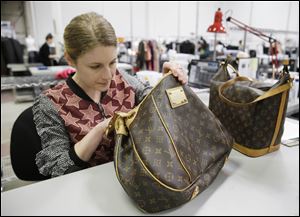
Web sites help consumers consider aftermarket worth in handbags, jeans
5/25/2014
Jenna Starr inspects a pair of Louis Vuitton handbags to authenticate them and make sure they meet brand standards at the headquarters of The RealReal in San Francisco. Other Web sites are helping shoppers resell their items faster, make more money, or buy upscale brands at a discount.
NEW YORK — Jenna Broems shops for clothes the same way she hunts for a new car: She considers resale value.
Ms. Broems, who lives in Stamford, Conn., only buys brands like Abercrombie & Fitch and 7 For All Mankind because she believes they will fetch the highest prices when she’s ready to move on.
“I’m now walking in like ‘What’s the return of this? Am I going to be able to resell?’ ” said Ms. Broems, 38, a teacher who has received $2,500 from stuff she’s resold on thredUP.com, an online resale site for used clothes.
Americans increasingly are considering the resale value when they shop for everything from jeans to handbags. The habit is in part because a growing number of Web sites make it easy for shoppers to buy and resell preowned goods.
It’s the latest reflection of the tough economy. Buying used goods at consignment shops became popular during the recession when Americans were hurting for extra cash.
The habit has stuck as people have grown used to wear the latest fashions without paying top dollar: Just as people lease a new car every couple of years so they’re always riding in style, reselling clothes is a way for Americans to trade up or splurge without spending a lot of extra cash.
The trend also is a consequence of the escalating cost of luxury. Rising prices of designer merchandise in recent years have tested the willingness of even affluent shoppers to pay full price. The price tag of a classic Chanel handbag, for example, is now $4,900 this year, up from $2,250 in 2007.
The size of the resale market is tiny: about 10 percent of overall luxury goods — including clothing, handbags, accessories, and home furnishings, are sold in the aftermarket — with about 1 percent of preworn goods sold online, estimates Forrester Research’s Sucharita Mulpuru.
But shoppers seem to have resale value in mind. According to a survey conducted last year by market research firm The Intelligence Group’s Cassandra Report, 44 percent of 900 shoppers between the ages of 14 and 34 think of resale value when they purchase things like electronics, furniture and clothing.
Shannon Dolan, who lives in San Francisco, said she’ll buy a Louis Vuitton handbag over a Gucci one based on how much she believes it will command if she resells it.
“It absolutely changed the way I shop,” said Ms. Dolan, who has made $10,000 selling clothes on online luxury resale marketplace TheRealReal.com, which focuses on the top-tier designer labels in fashion, accessories, and jewelry. “I’m really thinking of the value and investment of some of the things I’m buying.”
Resale sites have taken note. The sites marry the discounts found on resale online king eBay with tighter controls. Luxury sites such as Portero.com and TheRealReal, the largest seller of authenticated luxury resale goods with business expected to reach $100 million this year, have staff to make sure designer goods are authentic.
The sites also offer a faster way to sell than consignment stores, where shoppers can wait for months to have items sold and reap no more than 50 percent of the resale price. With the sites, items often sell within days and shoppers get as much as 80 percent of the resale value.
Many sites also have resale guides. ThredUP is loosely calling it a version of the Official Kelley Blue Book, referring to the online manual that offers resale values for cars. TheRealReal, which is coming out with a mobile app that’s a resale guide for consumers, said its calculations are based on prices of the 450,000 items it has sold since its founding in 2011.